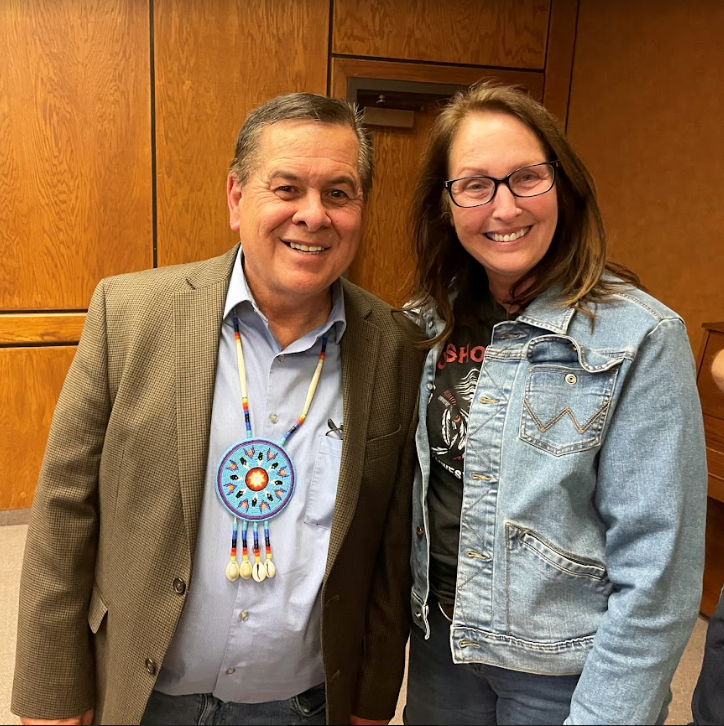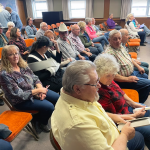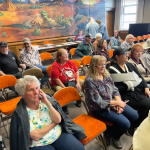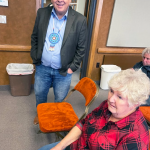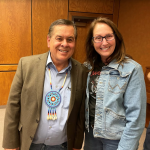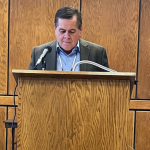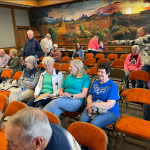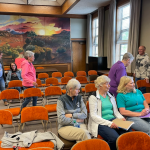By Cynthia Grant
Last week, the Emery County Historical Society welcomed Darren Parry, former Chairman of the Northwest Band of the Shoshone Nation and teacher at USU in Logan, to its monthly meeting. Parry is a direct descendant of a survivor of the Bear River Massacre of 1863.
Chief Sagwitch was his third great-grandfather. His grandmother Mae Timbimboo was the matriarch, record keeper and historian of her tribe. Mae heard and felt the painful stories from her grandfather Yeager Timbimboo. Parry grew up at her knees hearing the same stories from her. Mae told him to remember and tell their story.
The Bear River Massacre is an all but forgotten story of the only Indian tribe who never had a reservation. Three of the chiefs were charged with crimes and ordered to be arrested. The California Volunteer soldiers, deprived of fighting in the Civil War, were primed and ready for a battle. On January 29, 1863, Porter Rockwell, scouting for the Army, led Col. Patrick Connor and his soldiers from Fort Douglas to the Bear River winter grounds of the Shoshone. The army descended a snow-covered bluff to attack a sleeping Northwestern Shoshone village.
The Shoshone were wintering near hot springs as they had done for centuries, known as “Home of the Lungs.” The Bear River camp lay in the far northern section of Cache Valley near the present Utah and Idaho boundary line. In the zero-degree morning with four inches of snow on the ground, the horses were lathered and steaming as they charged.
Always up early, Sagwitch at first wondered what he was seeing. As he realized what was happening, he hurried to rouse the village telling them not to shoot first. The soldiers killed 400 Shoshone, two-thirds of whom were women and children. The killing began in the early morning and lasted into the afternoon. Arrows did little against the army’s guns and weapons.
Angichi, a Shoshone mother with seven bullet wounds, clutched her infant and jumped into the Bear River, where ten other women had done the same, to the safety of the overhanging bank and the warm springs. Angichi made the heart wrenching decision to drown her own child to keep it from crying and alerting soldiers above the cowering group. This woman lived to be over 100 years old. Soldiers stabbed, shot and beat a brave, Bear Hunter, but he would not cry out for mercy. Finally, a soldier heated a bayonet and ran him through from ear to ear.
Peter Maughan, called to settle the area, had earlier called the Shoshone “The Friendly Ones.” However, the encroachment of white settlers to farm the land destroyed resources for the hunter/gatherer people and set the stage for conflict. This led to what the whites termed atrocities. Parry explained that his people had three choices: beg for food, starve or steal. Grandmother Mae said, “We never stole anything, just collected rent.”
As early as 1847, Sagwitch traveled to Salt Lake hoping to speak with the leaders and welcome them. Since Brigham Young was ill, Heber C. Kimball met with him, “You Shoshone people don’t own the land… we calculate to plow and plant it.” It is ironic that the Saints who had suffered injustices were found guilty of wanting “the problem to be taken care.” Rout Smith gave voice to the sentiments of local Saints that it was “gruesome, but necessary.”
Parry intended to bring the audience “to the edge of uncomfortableness,” then to help us make the world a better place. The power of history connects us to the past, humanity and inhumanity, and offers a way to move forward. The 21st century needs respect for the truth and what has happened and the possibility for reconciliation. Values that strengthen community give marginalized people a voice. Parry told the group that “status is not how much you accumulate but how much we give away to bless others.” The solution to racism, prejudice and hate will come into our lives as we see each other as brothers and sisters. Oneness is not sameness.
A monument erected at the massacre site in the 1930s called it the “Battle of Bear River” and praised the courage and sacrifices of the soldiers while largely ignoring the suffering of the Shoshone. Like a small window in a large wall, this was one small view. A new plaque is being installed that also presents the Shoshone point of view. It reads: “Bear River Massacre — In memory of the estimated four hundred men, women and children of the Northwestern Shoshone Nation who were brutally massacred in this vicinity January 29, 1863, by the U.S. Army California Volunteers from Fort Douglas, Utah, under the command of Colonel Patrick E. Connor. The attack took place in the early morning hours against a group of people with limited defense and without peaceful means first being sought when a conflict arose. Twenty-three soldiers died as a result of the encounter. Chief Sagwitch and other survivors joined The Church of Jesus Christ of Latter-day Saints, established a thriving farming community known as Washakie, and many helped build the Logan Temple.”
Following his lecture, Darren Parry answered questions. One of the guests asked about the Northwestern Shoshone Tribe today. Parry explained that his people have largely assimilated into American culture. Membership is about 560 who have at least 1/8 Shoshone bloodlines. Among these, 450 live between Brigham City and Ogden.
Parry has been instrumental in purchasing 700 acres near the massacre site for an Interpretative and Language Center. An architectural firm in Salt Lake has kindly designed renderings of the Interpretive Center pro bono. The estimated cost of the center is $6 million and Parry has raised $4.5 million. Today, there are only 12 full speaking Shoshone. In addition, the Tribe has been able to obtain Federal grants to return the area back to how it would have been in the 1800s. A great deal of work is required to remove non-indigenous species and replant what his people used for food, complete with identification of the species.
The Emery County Historical Society expresses its gratitude to Parry and his wife Melanie for making the long trip for the evening presentation. Thanks also to the packed house of members who came to hear him.
The next historical society event will be a field trip on Saturday, June 18 to tour Tracy Behling’s dairy and visit several other sites in Ferron related to the dairy industry.

